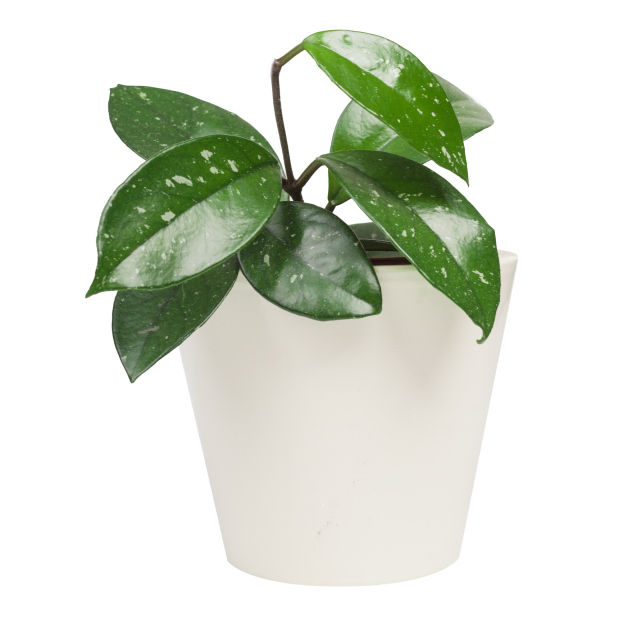
The Hoya Splash, also known as Hoya carnosa ‘Splash’, is a unique and stunning houseplant that’s beloved for its glossy, variegated leaves, which are splashed with creamy-white or silver markings. This hardy and low-maintenance plant is part of the Hoya family, often referred to as wax plants because of their waxy texture. With the right care, the Hoya Splash can thrive indoors and even reward you with fragrant, star-shaped flowers. If you’re interested in adding this beauty to your collection, here’s everything you need to know about caring for a Hoya Splash.
Hoya Splash thrives in bright, indirect light. It can tolerate some direct sunlight, but too much can scorch its leaves, causing them to turn yellow or brown. If your plant isn’t getting enough light, it may grow leggy with sparse foliage. To keep your Hoya Splash happy, place it near a bright window with filtered light, such as an east or west-facing window. If natural light is limited, you can supplement with a grow light to keep the plant healthy and encourage growth.
Hoya Splash, like most Hoyas, is quite drought-tolerant and prefers to dry out between waterings. Overwatering is one of the most common mistakes with this plant, as it can lead to root rot. To avoid this, water the plant thoroughly when the top 1-2 inches of soil feel dry to the touch. Always ensure your pot has proper drainage to prevent water from accumulating at the bottom.
During its growing season (spring and summer), you may need to water the plant more frequently, while in the winter months, when the plant’s growth slows down, you can water less often. As a general rule, it’s better to underwater than overwater a Hoya Splash, as it can tolerate dry conditions better than wet roots.
Hoya Splash prefers warm temperatures and does best in ranges between 60°F and 85°F (15°C to 29°C). It’s important to keep it away from drafts, air conditioners, or heaters, as sudden temperature fluctuations can stress the plant.
While Hoya Splash can tolerate average indoor humidity levels, it will thrive in higher humidity. If your home is particularly dry, especially during the winter months, consider placing the plant on a humidity tray, using a humidifier, or occasionally misting the leaves to maintain moisture in the air. However, be cautious with misting, as too much moisture on the leaves can lead to fungal issues.
Hoya Splash prefers a well-draining potting soil mix that retains some moisture but doesn’t stay soggy. A mix designed for succulents or cacti is a great option, or you can make your own by combining potting soil with perlite or orchid bark to ensure proper drainage. This plant does not like to sit in waterlogged soil, so it’s important to use a pot with drainage holes.
Repotting is generally only necessary every 1-2 years, or when the plant has outgrown its pot. When repotting, choose a container that’s slightly larger than the current one to give the roots room to grow, but avoid going too large, as this can lead to overwatering issues.
During the growing season (spring and summer), Hoya Splash will benefit from occasional feeding. Use a balanced, water-soluble fertilizer diluted to half strength, and fertilize once a month. This will encourage healthy growth and help the plant thrive. Avoid fertilizing in the fall & winter when the plant’s growth slows down. Over-fertilizing can lead to leggy growth or burned roots, so it’s important to use fertilizer sparingly.
Hoya Splash is a relatively low-maintenance plant, but occasional pruning can help maintain its shape and encourage fuller growth. If the plant becomes too leggy or has long, sparse vines, you can trim back the stems to promote bushier growth. Be sure to use clean, sharp scissors or pruning shears to avoid damaging the plant.
Additionally, the leaves of the Hoya Splash can accumulate dust over time, which can block sunlight and reduce photosynthesis. To keep the plant healthy, gently wipe the leaves with a damp cloth every few weeks to remove dust and debris.
One of the most rewarding aspects of owning a Hoya Splash is propagating it. This plant is easily propagated through stem cuttings. To propagate, cut a healthy stem with at least one leaf and a few nodes (the small bumps along the stem where new growth occurs). Place the cutting in water or a well-draining soil mix, and keep it in a warm, bright location. After a few weeks, the cutting should develop roots and can be potted into its own container.
Hoya Splash is known for its stunning, fragrant flowers, which appear in clusters of star-shaped blooms. These flowers can be white, pink, or red, with a waxy texture that gives them their signature look. While not all Hoya Splash plants will flower regularly, they’re more likely to bloom if they’re in a location with plenty of bright light, warmth, and humidity. Keep in mind that Hoyas can be slow to flower, and it may take a few years for a young plant to bloom.
Yes, Hoya Splash is non-toxic to pets. Unlike many other houseplants, this plant is safe to have around cats, dogs, and other animals. However, as with any plant, it's best to prevent pets from chewing on the leaves, as it could cause digestive upset, even though it’s not toxic.